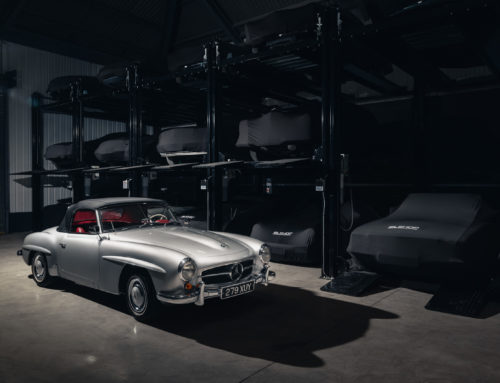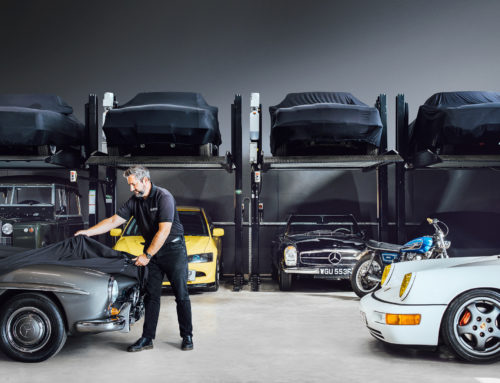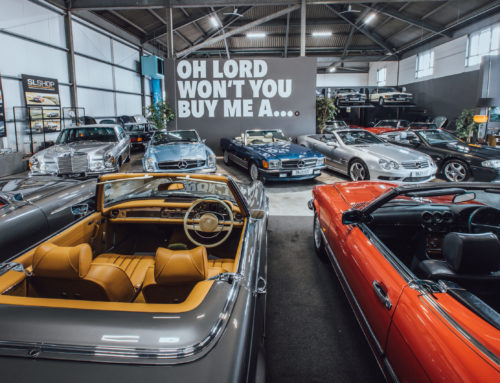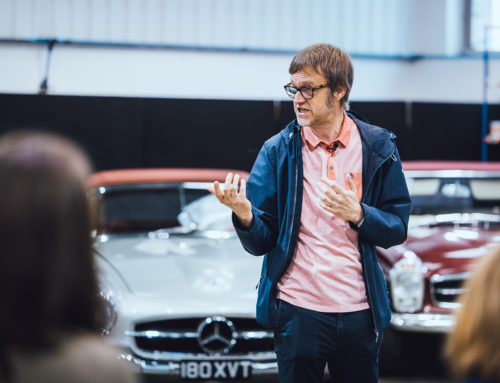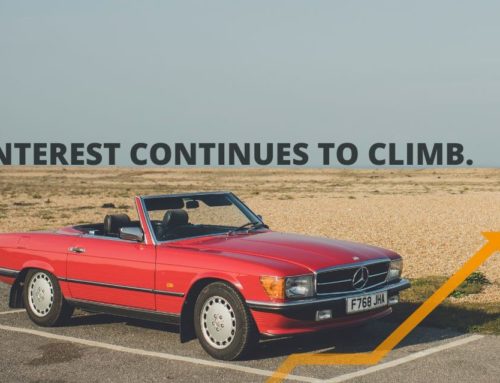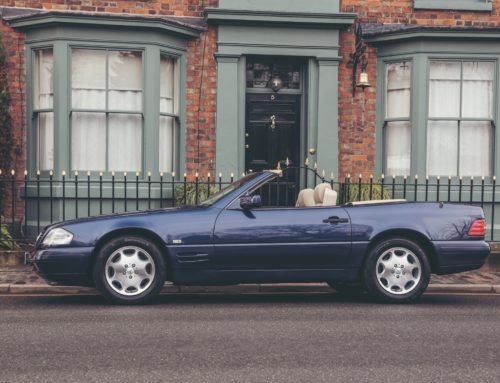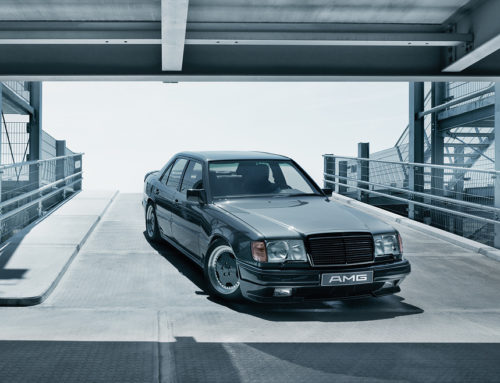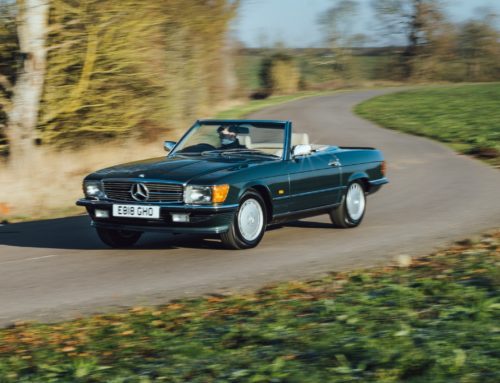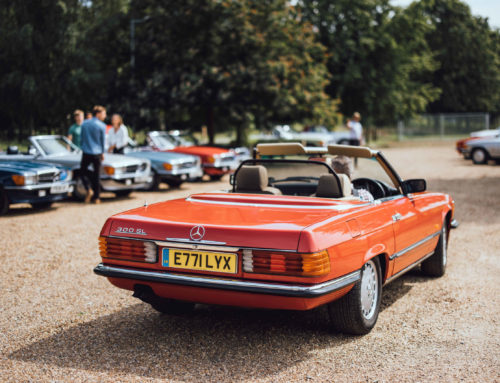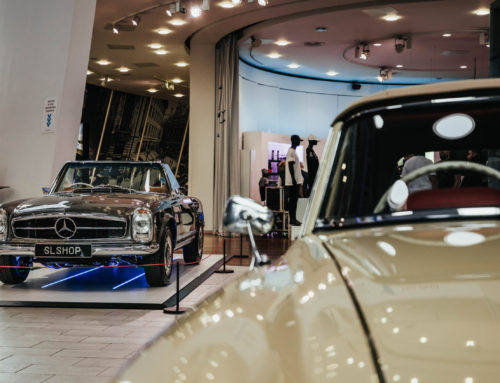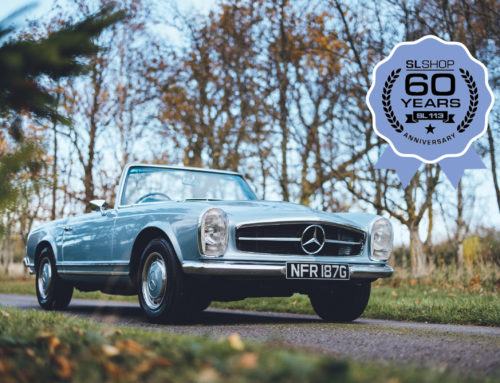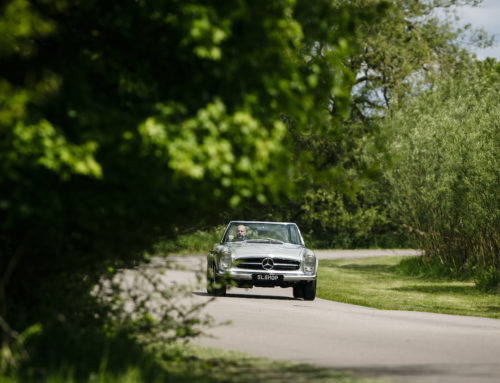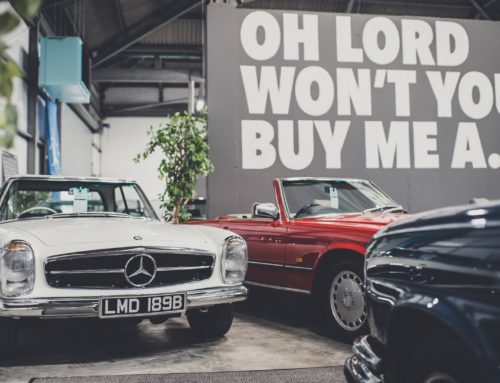Alex Riley, Comedian, Presenter of The Car Years and former script writer turned Top Gear Presenter gives an honest and heart-warming assessment of the importance of the 230SL to society. And given his love of vintage cars and clothes, who better to pen this month’s Super League Sermon. Without further ado, let’s tuck in…
In the history of the road-going SL the W113 might just be as important as the Gullwing, because it set the template for every SL that followed. It was a car that Mercedes worked hard to prove was a real sportscar, but which the world decided was something different, something special.
The arrival of the much cheaper 190SL alongside the Gullwing in 1954 may have been an inspired bit of brand extension but it also muddied the waters. It might’ve looked like a slightly plump Gullwing from the windows down, but with innards from the bread and butter 180 saloon it was no thoroughbred. And with just 105 bhp and a hefty kerbweight, performance was leisurely. ‘True’ sportscar fans rejected it as a poseurs special, but it found its own market among a clientele more interested in aspirational style than macho posturing.
When British journalist David Scott-Moncrieff commented on its less than stellar performance, Mercedes racing chief Alfred Neubauer told him ‘you expect too much, this is just a car for pretty girls’. An exaggeration perhaps, but in Frankfurt particularly, the 190SL was surprisingly popular among fashionable young women, chief among them the notorious society prostitute Rosemarie Nitribitt. Her black SL with red upholstery was a familiar sight around the better parts of the city where her influential clientele worked and played. In Germany the 190SL became known as the Nitribitt-Mercedes. Outside Germany, it gained a more reputable kind of glamour from Grace Kelly’s character driving one in the film High Society and celebrity owners like Zsa Zsa Gabor and Gina Lollobrigida.
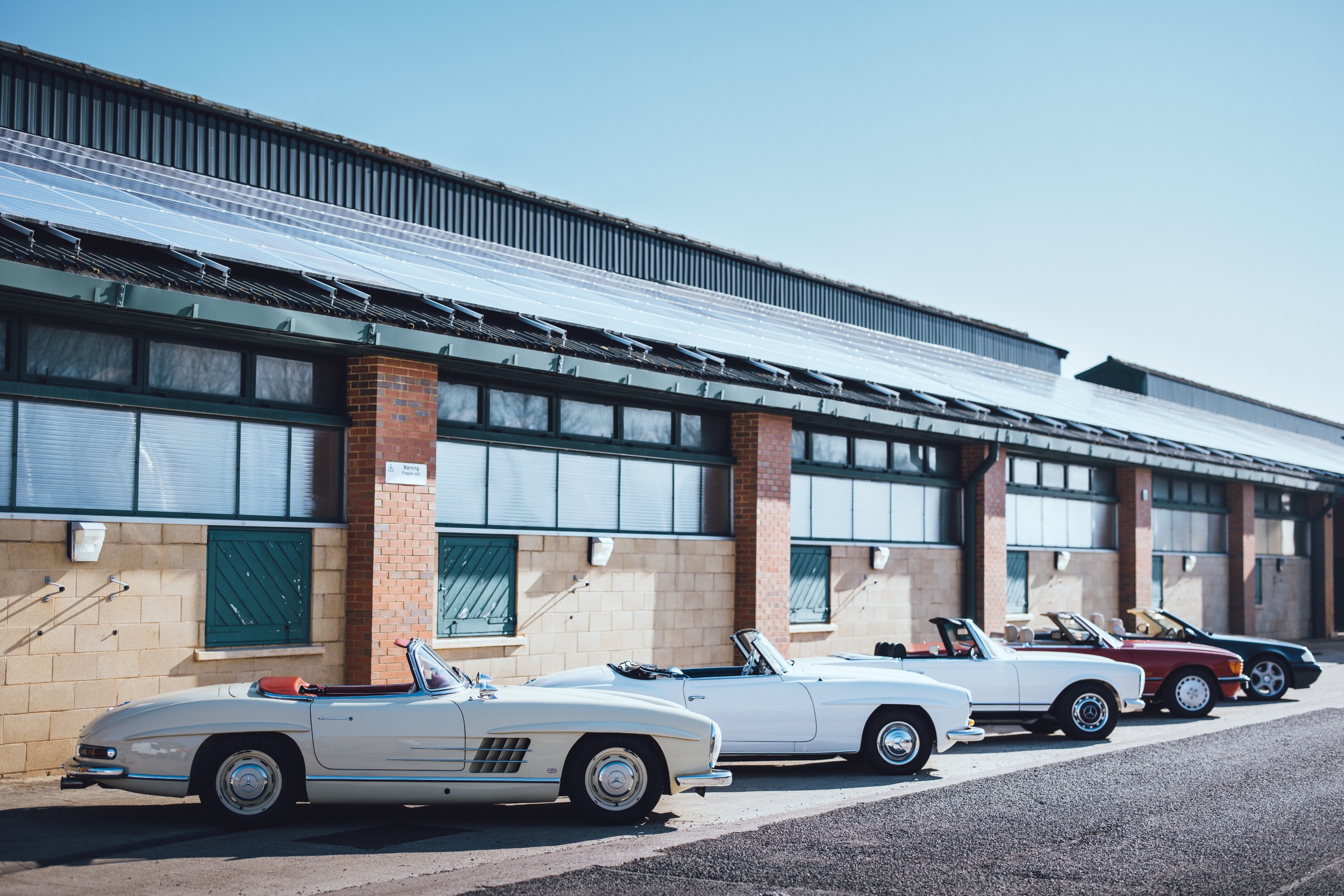
But by 1960 sales of the 300SL roadster and 190SL were in decline. And Mercedes was no longer involved in high-end motorsport so a supercar was off the agenda. One car would replace them both, tasked with combining the aspirational appeal of the 190SL with some of the 300SL’s credibility. It would be a compact two seater, fast enough to be exciting but with a cossetting ride and sensational roadholding.
Styling duties fell to Frenchman Paul Bracq. Early ideas had kept the baroque detailing of the 300SL, but wisely everything bar the horizontal grille and combined headlamp and indicator units was junked. The final result was a model of linear elegance, immediately setting it apart from more flamboyant or aggressive designs from the likes of Chevrolet, Jaguar or Alfa Romeo. And where the Corvette’s styling would receive annual tweaks, and the E-type’s stunning looks be diluted to comply with safety legislation, the SL stayed almost completely unchanged throughout its life.
The distinctive ’Pagoda’ roof had sprung from the mind of Béla Barényi, who had joined Mercedes in 1939 to explore new ideas. To give a roof panel the requisite strength, it would typically have a 10mm curvature pressed into it, the highest point being in the middle. Barényi worked out that by reversing the curvature, the side windows would extend higher, improving headroom and enhancing visibility. Thick pillars also gave rollover protection, and safety was a big deal at Mercedes.
The 220 ‘Fintail’ saloon had been the first car to fully incorporate Barényi’s ideas of a rigid centre section with deformable ‘crumple zones’ at either end. As the W113 was based on a shortened 220 platform it got them too. With a welded-on body this made the SL extremely rigid. Inside, the steering wheel and dash featured padding and all interior fittings and controls were designed to breakaway or absorb energy in an accident. This designed-in safety would help the SL avoid the ugly compromises forced on some of its rivals by new American safety legislation in 1968.
In charge of engineering was Rudi Uhlenhaut, mastermind behind Mercedes’ mid-Fifties motorsport dominance and a brilliant driver to boot. Ultimate roadholding was the goal which meant radial tyres, but for ride comfort crossplies were king. Working alongside Firestone, a special wide, low profile tyre was developed specially for the 230SL which featured diagonal bracing that allowed roadholding and ride comfort to co-exist harmoniously. A rib was also moulded into the sidewall protecting the rims from damage.
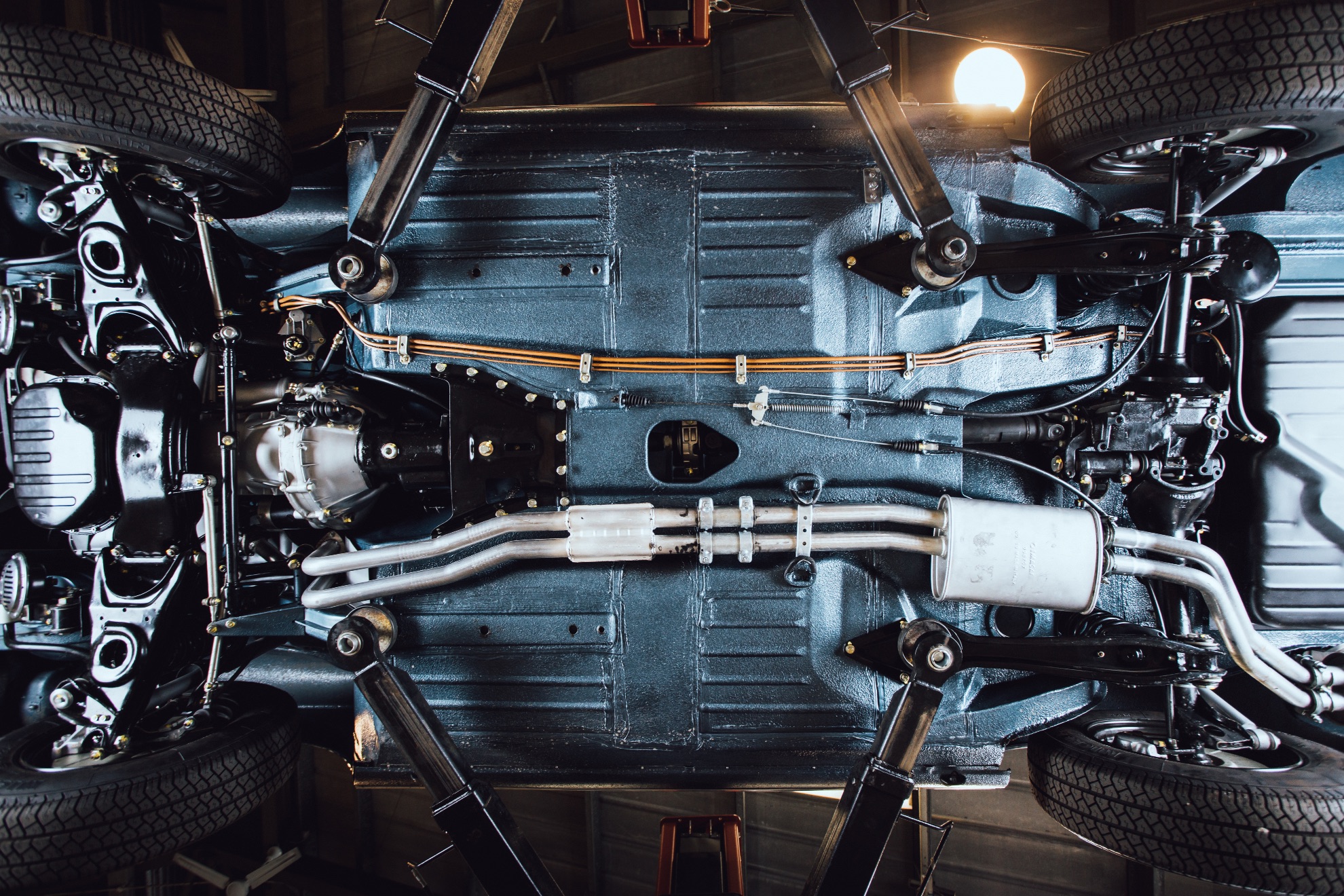
A 280SL undercarriage from SLSHOP’s Workshops.
Suspension would be independent all round, with unfashionable swing axles at the rear. The Gullwing’s rear suspension allowed large variations in camber angle – like a Triumph Herald – making it a twitchy nightmare for anyone lacking the skills of a Fangio or Moss. But by putting the pivot point low down under the rear differential, the roll centre height was lowered and a horizontal compensator spring helped keep the wheels upright. Coupled with a very wide track, camber changes were minimal. In fact, under compression the wheels gave negative camber.
To demonstrate to journalists at the1963 Geneva show just how well it worked, Uhlenhaut booked the nearby Annemasse Vetraz Monthoux circuit, completing a tight and twisty lap in 47.3 seconds, two tenths quicker than Mike Parkes in a Ferrari 250GT. The same year, the 230SL would emphatically demonstrate its speed and durability by winning the gruelling Liege-Sofia-Liege rally outright.
Power was rated at 150 hp, considerably more than the 190 but some way short of the 300SL. The four-bearing straight six came from the 220 saloon, significantly uprated and at the last-minute, increased in size to 2.3 litres. Performance was good, if not outstanding.
In reality, production engines developed around 142bhp, and needed to be revved, hampered by strange gaps in the gearing. And Mercedes had forgotten about the impact of drag. The extreme width of the 230SL offered advantages in roadholding, but its frontal area was huge for a roadster. And when Mercedes wind-tunnel tested a 230SL in 2012, its drag coefficient was found to be a very poor 0.52. For reference, the 1954 190SL’s was 0.46. Given that drag influences both top speed and acceleration this was a missed opportunity.
Mercedes sought to improve matters by bringing the gear ratios closer together, and then, with an optional close-ratio 5 speed gearbox. This improved acceleration and allowed for more relaxed cruising in overdrive 5th, and was popular in Italy, but elsewhere take-up was poor. Four wheel disc brakes and more torque arrived with the 250SL as did an optional limited slip differential. The 280SL would get the most power and achieve record sales, , but with 77% of customers ordering the automatic gearbox it was obvious they weren’t interested in the last word in performance. Other coupes and convertibles already offered considerably more power and were usually cheaper, but few combined the SLs very high levels of roadholding with such excellent ride comfort, convenience and refinement.
Helping the W113’s cause, was Mercedes’ reputation was reaching new heights. The Grosser-Mercedes, the 600, also arrived in 1963. An engineering tour-de-force, it was recognised by many as the best car in the World. Heads of state and rock stars flocked to it, and its status rubbed off on the SL. At the same time, Mercedes finally took control of their own nationwide American sales and service network – up to 1963 they’d had to rely on sales and service through Studebaker dealers.
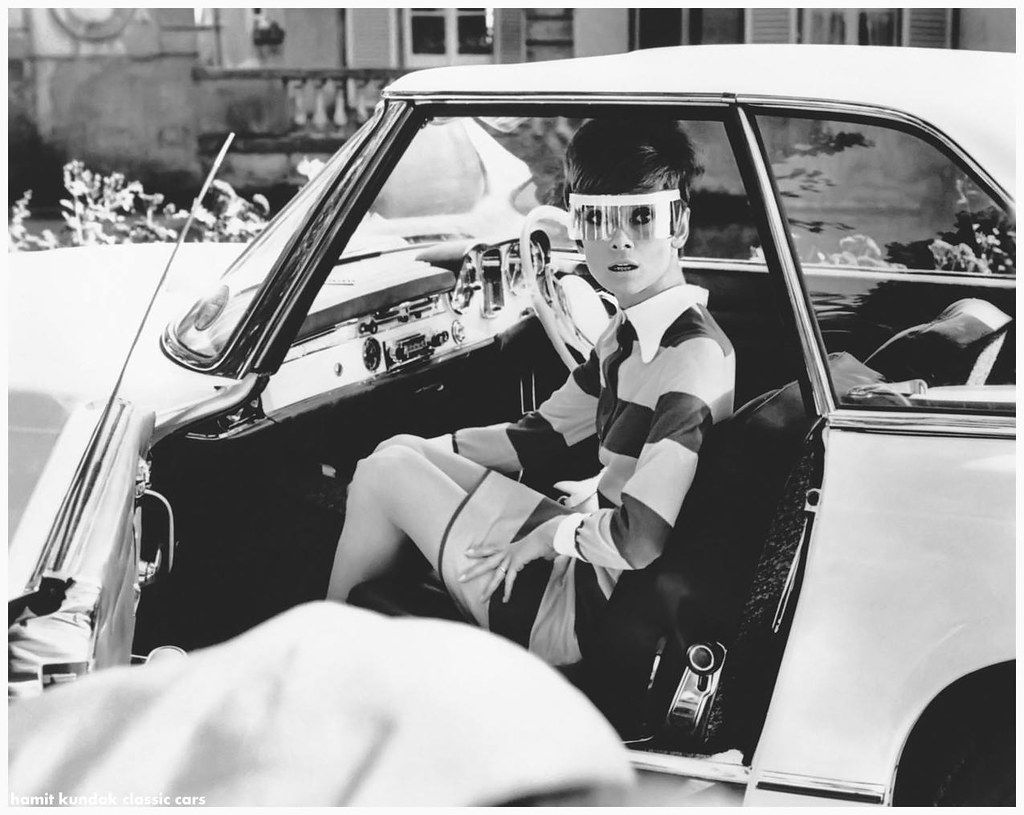
Owning an SL became emblematic of a kind of intelligent sophistication, a way of enjoying your success without appearing vulgar. European and American celebrities flocked to it including Audrey Hepburn, King Hussein of Jordan, Burt Reynolds, Twiggy, Peter Ustinov and John Lennon. Moss and Fangio had them too. And in films like Two For the Road and Charade, glamorous and successful female characters, played by Audrey Hepburn and Sophia Loren drove 230SLs.
To understand how the W113 helped the SL come of age, consider the example of Natalie Wood. In 1958, as a 19 year-old starlet, she’d bought a silver 300SL roadster with a red interior and had it painted bright pink – its outrageous glamour designed to attract the attention of Hollywood producers, casting directors and the press. In 1967, as a wealthy and established film star, able to afford whatever car she liked, she bought a 250SL, in white, as a car just to drive.
Eventually Mercedes realised that an SL didn’t need to be a sportscar – it was a fast, refined, and beautifully engineered car that occupied a niche of its own.
And what was true in the 60’s still holds true today. Sixty years on, see a 230, 250 or 280SL on the street or in an advert or film, and it’s still an instantly recognisable symbol of intelligence, sophistication and understated style.
Want to share a story about your W113 Pagoda? Get in touch via Journal@theSLSHOP.com
Share With Your Fellow Enthusiasts
Alex Riley, Comedian, Presenter of The Car Years and former script writer turned Top Gear Presenter gives an honest and heart-warming assessment of the importance of the 230SL to society. And given his love of vintage cars and clothes, who better to pen this month’s Super League Sermon. Without further ado, let’s tuck in…
In the history of the road-going SL the W113 might just be as important as the Gullwing, because it set the template for every SL that followed. It was a car that Mercedes worked hard to prove was a real sportscar, but which the world decided was something different, something special.
The arrival of the much cheaper 190SL alongside the Gullwing in 1954 may have been an inspired bit of brand extension but it also muddied the waters. It might’ve looked like a slightly plump Gullwing from the windows down, but with innards from the bread and butter 180 saloon it was no thoroughbred. And with just 105 bhp and a hefty kerbweight, performance was leisurely. ‘True’ sportscar fans rejected it as a poseurs special, but it found its own market among a clientele more interested in aspirational style than macho posturing.
When British journalist David Scott-Moncrieff commented on its less than stellar performance, Mercedes racing chief Alfred Neubauer told him ‘you expect too much, this is just a car for pretty girls’. An exaggeration perhaps, but in Frankfurt particularly, the 190SL was surprisingly popular among fashionable young women, chief among them the notorious society prostitute Rosemarie Nitribitt. Her black SL with red upholstery was a familiar sight around the better parts of the city where her influential clientele worked and played. In Germany the 190SL became known as the Nitribitt-Mercedes. Outside Germany, it gained a more reputable kind of glamour from Grace Kelly’s character driving one in the film High Society and celebrity owners like Zsa Zsa Gabor and Gina Lollobrigida.

But by 1960 sales of the 300SL roadster and 190SL were in decline. And Mercedes was no longer involved in high-end motorsport so a supercar was off the agenda. One car would replace them both, tasked with combining the aspirational appeal of the 190SL with some of the 300SL’s credibility. It would be a compact two seater, fast enough to be exciting but with a cossetting ride and sensational roadholding.
Styling duties fell to Frenchman Paul Bracq. Early ideas had kept the baroque detailing of the 300SL, but wisely everything bar the horizontal grille and combined headlamp and indicator units was junked. The final result was a model of linear elegance, immediately setting it apart from more flamboyant or aggressive designs from the likes of Chevrolet, Jaguar or Alfa Romeo. And where the Corvette’s styling would receive annual tweaks, and the E-type’s stunning looks be diluted to comply with safety legislation, the SL stayed almost completely unchanged throughout its life.
The distinctive ’Pagoda’ roof had sprung from the mind of Béla Barényi, who had joined Mercedes in 1939 to explore new ideas. To give a roof panel the requisite strength, it would typically have a 10mm curvature pressed into it, the highest point being in the middle. Barényi worked out that by reversing the curvature, the side windows would extend higher, improving headroom and enhancing visibility. Thick pillars also gave rollover protection, and safety was a big deal at Mercedes.
The 220 ‘Fintail’ saloon had been the first car to fully incorporate Barényi’s ideas of a rigid centre section with deformable ‘crumple zones’ at either end. As the W113 was based on a shortened 220 platform it got them too. With a welded-on body this made the SL extremely rigid. Inside, the steering wheel and dash featured padding and all interior fittings and controls were designed to breakaway or absorb energy in an accident. This designed-in safety would help the SL avoid the ugly compromises forced on some of its rivals by new American safety legislation in 1968.
In charge of engineering was Rudi Uhlenhaut, mastermind behind Mercedes’ mid-Fifties motorsport dominance and a brilliant driver to boot. Ultimate roadholding was the goal which meant radial tyres, but for ride comfort crossplies were king. Working alongside Firestone, a special wide, low profile tyre was developed specially for the 230SL which featured diagonal bracing that allowed roadholding and ride comfort to co-exist harmoniously. A rib was also moulded into the sidewall protecting the rims from damage.

A 280SL undercarriage from SLSHOP’s Workshops.
Suspension would be independent all round, with unfashionable swing axles at the rear. The Gullwing’s rear suspension allowed large variations in camber angle – like a Triumph Herald – making it a twitchy nightmare for anyone lacking the skills of a Fangio or Moss. But by putting the pivot point low down under the rear differential, the roll centre height was lowered and a horizontal compensator spring helped keep the wheels upright. Coupled with a very wide track, camber changes were minimal. In fact, under compression the wheels gave negative camber.
To demonstrate to journalists at the1963 Geneva show just how well it worked, Uhlenhaut booked the nearby Annemasse Vetraz Monthoux circuit, completing a tight and twisty lap in 47.3 seconds, two tenths quicker than Mike Parkes in a Ferrari 250GT. The same year, the 230SL would emphatically demonstrate its speed and durability by winning the gruelling Liege-Sofia-Liege rally outright.
Power was rated at 150 hp, considerably more than the 190 but some way short of the 300SL. The four-bearing straight six came from the 220 saloon, significantly uprated and at the last-minute, increased in size to 2.3 litres. Performance was good, if not outstanding.
In reality, production engines developed around 142bhp, and needed to be revved, hampered by strange gaps in the gearing. And Mercedes had forgotten about the impact of drag. The extreme width of the 230SL offered advantages in roadholding, but its frontal area was huge for a roadster. And when Mercedes wind-tunnel tested a 230SL in 2012, its drag coefficient was found to be a very poor 0.52. For reference, the 1954 190SL’s was 0.46. Given that drag influences both top speed and acceleration this was a missed opportunity.
Mercedes sought to improve matters by bringing the gear ratios closer together, and then, with an optional close-ratio 5 speed gearbox. This improved acceleration and allowed for more relaxed cruising in overdrive 5th, and was popular in Italy, but elsewhere take-up was poor. Four wheel disc brakes and more torque arrived with the 250SL as did an optional limited slip differential. The 280SL would get the most power and achieve record sales, , but with 77% of customers ordering the automatic gearbox it was obvious they weren’t interested in the last word in performance. Other coupes and convertibles already offered considerably more power and were usually cheaper, but few combined the SLs very high levels of roadholding with such excellent ride comfort, convenience and refinement.
Helping the W113’s cause, was Mercedes’ reputation was reaching new heights. The Grosser-Mercedes, the 600, also arrived in 1963. An engineering tour-de-force, it was recognised by many as the best car in the World. Heads of state and rock stars flocked to it, and its status rubbed off on the SL. At the same time, Mercedes finally took control of their own nationwide American sales and service network – up to 1963 they’d had to rely on sales and service through Studebaker dealers.

Owning an SL became emblematic of a kind of intelligent sophistication, a way of enjoying your success without appearing vulgar. European and American celebrities flocked to it including Audrey Hepburn, King Hussein of Jordan, Burt Reynolds, Twiggy, Peter Ustinov and John Lennon. Moss and Fangio had them too. And in films like Two For the Road and Charade, glamorous and successful female characters, played by Audrey Hepburn and Sophia Loren drove 230SLs.
To understand how the W113 helped the SL come of age, consider the example of Natalie Wood. In 1958, as a 19 year-old starlet, she’d bought a silver 300SL roadster with a red interior and had it painted bright pink – its outrageous glamour designed to attract the attention of Hollywood producers, casting directors and the press. In 1967, as a wealthy and established film star, able to afford whatever car she liked, she bought a 250SL, in white, as a car just to drive.
Eventually Mercedes realised that an SL didn’t need to be a sportscar – it was a fast, refined, and beautifully engineered car that occupied a niche of its own.
And what was true in the 60’s still holds true today. Sixty years on, see a 230, 250 or 280SL on the street or in an advert or film, and it’s still an instantly recognisable symbol of intelligence, sophistication and understated style.
Want to share a story about your W113 Pagoda? Get in touch via Journal@theSLSHOP.com
Share With Your Fellow Enthusiasts
More from Journal
CARE
THE ULTIMATE CERTIFIED SERVICING INVESTMENT PLAN
Your ownership journey matters to us, which is why we have created a simple certified servicing investment plan, tailored to your individual needs and aspirations.
Start investing today and our dedicated CARE team will work with you to increase the value and enjoyment you receive from your vehicle.

STAY IN TUNE WITH SLSHOP MOMENTS
As part of SLSHOP’s community of enthusiasts, you’ll be the first to hear about events and tours, key product offers, exciting stories from owners around the world and of course… our latest additions to the showroom. So, be the first to know and you might just sneak a car on your driveway or take your car’s condition to new heights with our exclusive replacement parts.
Or, visit SLSHOP Journal



